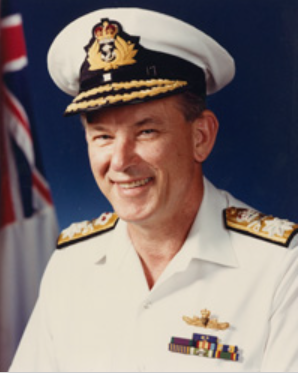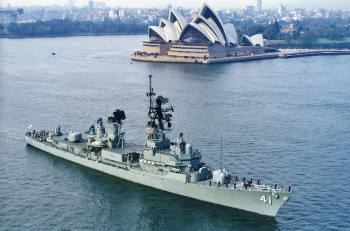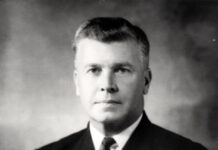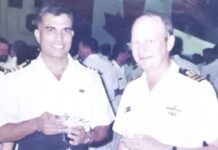
By John Mortimer and John Perryman
On 28 August 2023 Vice Admiral Robert Andrew Kevin Walls passed away after a long illness. He was an officer who developed into an insightful strategic thinker and made a significant contribution to the post-carrier RAN.
Robert Walls was born at Colac, Victoria, on 15 March 1941 and was educated at country schools before joining the Royal Australian Navy College (RANC) when it was still at Flinders Naval Depot/HMAS Cerberus following the Depression-era strictures. Joining in 1955 his class was the last 13-year old entry. During his training the RANC was relocated to its original site at Jervis Bay, commissioning as HMAS Creswell in February 1958. The discipline at the RANC during the FND years could be harsh and young Cadet Midshipman Walls found it tough going at times and even contemplated leaving the College.
Following graduation Rob Walls, who was also known by his initials ‘RAK’, initially went to sea in the training sloop HMAS Swan. In April 1959 he and his classmates left Australia to join the Britannia Royal Naval College (BRNC), Dartmouth, UK, for continuation training.
Midshipman Walls found the environment at Dartmouth much to his liking, enjoying his time both at BRNC, and in the Type 15 frigate HMS Vigilant, at that time operating in the West Indies as part of the Dartmouth training squadron.
As a sub lieutenant he continued his training in the aircraft carrier HMAS Melbourne and then the frigate HMAS Quiberon. In 1962 he undertook the Destroyer Gunnery Officers’ course and then served as gunnery officer in the frigate HMAS Quickmatch. The Qs were successful stop-gap anti-submarine frigates, but they could not hide their World War II destroyer austereness.
In 1964 Lieutenant Rob Walls was part of the commissioning crew for the Type 12 frigate HMAS Derwent. Armed with Seacat, she was the RAN’s first warship to be missile armed and represented the latest word in Cold War frigate design. Rob Walls remained in Derwent until mid-1965 during which time he saw operational service off Borneo and Malaysia during the ‘Indonesian Confrontation’.
In 1965 Rob Walls’ next sea posting was to the guided missile destroyer HMAS Hobart under the command of Captain Guy Griffiths. He joined in the US as part of the commissioning crew and undertook a range of courses including the Air Intercept Controller (AIC) course. Hobart was the first of the RAN DDGs to receive the full systems and operations training in the US. For Rob Walls the complexity of the DDG, combined with the sophistication of the US technical and operational training was a revelation.
Hobart was the first of the RAN destroyers to serve in the Vietnam War. Notably, Captain Griffiths organised for Rob Walls and Leading Seaman Corrie Halliwell to serve as AICs for a period in the nuclear-powered cruiser USS Long Beach off the North Vietnam coast. They were the first RAN personnel to be exposed to the duties of Positive Identification Radar Advisory Zone or PIRAZ procedures and more significantly the new Naval Tactical Data System (NTDS). He saw first hand the power of combat data systems to knit together weapons and sensors. In Long Beach Rob Walls controlled Combat Air Patrol (CAP) aircraft and ran intercepts using USN F4 Phantom aircraft against the North Vietnamese fighters. Hobart’s outstanding deployment, in which she came under shore-fire on numerous occasions, led to the ship being awarded a United States Navy Unit Commendation for meritorious service.
Captain Griffiths was a major influence on Rob Walls’ approach to his naval career. Rob would later write, “the superior training and morale of his crew was a fine match for his calm demeanour and masterful ability to create trust and commitment amongst his men.” Rob Walls and Guy Griffiths would remain in regular touch until Rob’s last days. Rob Walls wrote the Foreword to Peter Jones’ biography of Rear Admiral Griffiths and one of his last public appearances was at the launch of the book at the Australian War Memorial.
Later in life Rob Walls credited his time in Hobart with learning not only important war fighting skills but some of life’s most valuable and lasting lessons. Moreover, that experience instilled in him the value and importance of mentoring others, something Rob Walls continued to do all his life and there were many who were to benefit from his time, consideration and wise counsel.
In 1968 Lieutenant Rob Walls returned to the UK and after completing the Royal Navy Direction Officer’s course at HMS Dryad he served in 893 Squadron, then attached to the aircraft carrier HMS Hermes, in the Atlantic and Mediterranean, and at RNAS Yeovilton, Somerset, as Training Officer at the Direction School.
Promoted lieutenant commander in 1971, he returned to Australia and to sea in the destroyer HMAS Perth as the ship’s Direction Officer, before joining the Navigation & Direction School at HMAS Watson in 1973 as a Training Officer. His next appointment was on the staff of the Flag Officer Commanding the Australian Fleet (FOCAF), as Fleet Direction Officer from 1975-1976, a position he held until appointed executive officer of Perth in January 1977.
In 1978 Commander Walls served in Navy Office for the first time in the Operational Requirements Branch, as the Follow-On Destroyer Project Officer. In that position Rob Walls was responsible for preparing the case for the new destroyer. His major contribution was the preparation of the draft Defence Navy Destroyer Group Report of June 1980. Rob’s commentary on and analysis of the seven ship options was central to this report’s findings. The report was considered by Defence’s Force Structure Committee and resulted in the construction of the guided missile frigates HMA Ships Melbourne and Newcastle at Williamstown. During that process Rob was exposed to the workings and challenges of progressing Navy proposals through senior Defence Committees, which stood him in good stead for future postings.
At the end of 1981 Commander Walls was appointed in command of the RAN’s heavy lift ship HMAS Tobruk. This was to prove a rewarding appointment with one of Tobruk’s first operational missions being to transport eight UH-1H helicopters and stores to Israel in support of a United Nations sponsored Multi-National Force operating in the Sinai Desert.
During his time in command of Tobruk, the ship grounded in the Brisbane River, a potentially career-ending event. The Fleet Commander at the time, Rear Admiral Mike Hudson, was a navigational specialist who understood the complexities Rob was facing in the river. He embarked in Tobruk soon thereafter to gain a first-hand assessment and was well satisfied with her captain and the ship’s organisation. Rob remained in command. In his performance report, subsequent to the grounding, Rob was described: “He’s generally met the challenges of ship handling but has at times not paid sufficient attention to navigation detail. Particularly important in a ship with that role. A recent unintentional grounding has probably corrected any tendency to overlook such detail and I do not expect any further misjudgements.” The report went on to recommend him for promotion.
Following his command in June 1983, Rob Walls was appointed Commander Australian Amphibious Squadron and Commanding Officer of the shore establishment HMAS Moreton, situated on the Brisbane River.
Promoted captain in 1984 his next appointment was a return to Canberra as the Director of Naval Force Development (DNFD) in Navy Office. The following year Vice Admiral Hudson became the Chief of Naval Staff (CNS) with the task of leading the Navy into its post-aircraft carrier future. Rob Walls’ intellect and toughness were much valued by the new CNS in that challenging time.
During this posting, Rob Walls was heavily involved with providing the Navy’s input to the Dibb Review and the White Paper Defence of Australia 1987 (DOA87). One of his major influences was the analysis of major surface combatant numbers required for concurrent presence in five broad northern Australian maritime areas. He concluded that the RAN required a force of 16 to 17 major surface combatants. His analysis was accepted by the review and was reflected in their report, and later DOA 87. In recognition of his achievements as DNFD Rob Walls was made a Member of the Order of Australia in June 1987.

Rob Walls assumed command of the destroyer HMAS Brisbane in June 1987 while the ship was undertaking an extensive half-life modernisation. That command capped off service at sea in all three of the RAN’s guided missile destroyers, and Rob later described it as the most enjoyable posting of his 42-year naval career. Rob Walls was a tough captain who set high standards. His approach suited the ship and the times, and with his Executive Officer (XO), Commander Garry Kennedy, they proved a formidable team, creating an efficient and happy ship, that worked hard and played hard.
Garry Kennedy recalls, when he posted to Brisbane in December 1987 “he felt at the time, then Captain Walls was quite sceptical about having a diver as XO, rather than a fully qualified Principal Warfare Officer (PWO). Our initial relationship was a bit guarded but after my settling in period, we became very close and subsequently good friends, both during my tenure in Brisbane and beyond as Rob passed through the promotions of his career. Rob was also the Maritime Commander when I was CO Tobruk and he chose to have his handover ceremony onboard Tobruk.”
Rob Walls was promoted Commodore in 1988 before attending the National Defence College (NDC), New Delhi, India in 1989. When Rob went to the NDC in India, he asked Garry Kennedy to store his fine wines as he didn’t want them in the normal storage. Garry stored the wine under his house in suburban Canberra where it was cool but when Rob came to collect the wine on his return, snails had gorged themselves on all the labels. Neither Rob nor Garry had any idea which wines were which. They decided that the collection should be known as the wine ‘lucky dip’. During his time in India, Rob Walls learnt fly fishing in the Himalayas and for many years it was to be a pastime of endless fascination. He and Rear Admiral David Campbell would often embark on fly-fishing expeditions in both Australia and New Zealand.
Returning to Australia the following year Rob Walls was appointed Director General Naval Policy and Doctrine. That posting was to coincide with heightened tensions in the Middle East following Iraq’s invasion of Kuwait and the advent of the Gulf War. A team of three, led by Commodore Walls, and comprising Captains Tim Cox and Boyd Robinson were sent to the Middle East by RAAF VIP jet, to set up arrangements for the RAN’s initial deployment and its sustainment. Prior to deployment Rob Walls briefed the Minister for Defence, Senator Robert Ray, on the planned scope and approach of the team. He received the Minister’s endorsement and was given flexibility to make arrangements as he saw fit to progress matters. During that time Rob’s expertise was drawn upon to evaluate and dissect the complexities of the operation to liberate Kuwait, developing a concept of operations, taking the lead in establishing Rules of Engagement for the RAN task group, and representing Australia at the respective Multinational Planning Conferences in preparation for Operations Desert Shield and Desert Storm.
In 1991 Rob Walls was promoted to Rear Admiral and he initially took up his posting as the Deputy Chief of Naval Staff towards the end of Vice Admiral Hudson’s tenure. The incoming CNS, Vice Admiral Ian Macdougall arrived in March 1991, with an agenda to introduce a new management system, known as Naval Quality Management (NQM). This was the root cause of considerable friction between the two, and no doubt resulted in Rob’s replacement after a relatively short term. Rob’s replacement, Rod Taylor was also opposed to NQM, as were many others in Navy.
In November 1991 Rear Admiral Walls was appointed Maritime Commander. In Exercise RIMPAC ’92 he served as the Battle Force Commander of USN, USAF, Canadian, Korean, and Australian Task Groups. In December 1992 he oversaw the deployment of Tobruk and the training ship HMAS Jervis Bay to Somalia as part of Operation Solace. This was the largest Australian military sealift operation since the Vietnam War.
Among other things, Operation Solace validated Rob Walls’ belief in the important role that women would play in the future of modern naval fighting forces. After some early false steps in the RAN’s introduction of women at sea, Rob Walls memorably cleared lower deck of the Fleet at Garden Island to give every officer and sailor his unvarnished expectations of each and every one of them.
Rob Walls remained a life-long advocate of exploiting information and understood the value of smart information systems – classified or not. He created the position of Chief Staff Officer Command Control Communications Intelligence (C3I) in Maritime HQ to consolidate all these areas within the command.
Rob Walls took to heart that preparing for combat meant that high standards were the only standards. He strongly associated himself with Admiral Sir Sandy Woodward’s maxim that combat required hard-nosed leaders who knew how to get the best from their people, but that some failures would emerge, who had to be moved on for the betterment of the Navy. Rob Walls did not tolerate those who did not have what it took to get results. As Maritime Commander, Rob Walls made that point directly to his commanding officers as well as his staff, and some had a very hard time.
Rear Admiral Wendy Malcolm served as Flag Lieutenant to Rob Walls during this time. She vividly remembers the way in which Rob Walls drove the Fleet, the staff and applied a relentless demand for excellence. He was a “fearsome leader” and even some seasoned operators could shake in their boots when Rob Walls would ask “What’s on your mind?” They would speak – Rob’s eyes would narrow and a long uncomfortable pause would follow. Many would dive headfirst into the abyss and keep talking, some committing career suicide in the process. They had been famously sent “to the other side of the Wall”. One of Rob’s characteristics when angry was to call the person he was speaking to “pal”. That was usually a sign things were going to deteriorate.
Yet most people prospered in striving to meet Rob Walls’ demand for excellence. Along with many others, Wendy Malcolm was strongly encouraged by Rob Walls. “He was the first person to make me think I was worthy of achieving something with my life – his support, his advice and his friendship stood me in good stead for more than thirty years”. He was always willing to listen, to help and thought about things deeply. “Rob was a great friend and mentor who shared great advice and many a good joke”.
During 1994-1995 Rear Admiral Walls served as the Assistant Chief of the Defence Force for Capability Development. In that role he enjoyed myriad responsibilities including the shift of the ADF’s focus from the southeast of the Australian continent to the west and the north, the 1994 Defence White Paper, the Ten Year Defence Plan and the ‘mopping up’ following the Force Structure Review.
In 1995 Rob Walls was subsequently promoted Vice Admiral and appointed Vice Chief of the Australian Defence Force, a position he held until his retirement from uniformed service in March 1997. Vice Admiral David Shackleton sums up Rob Walls in the following terms, “He was a great networker and built relationships across multiple disciplines, military and civilian, across all of defence – and then in the private sector where he had a senior role with ADI and then CEA. He had good relationships with ministers and he and Senator Ray seemed to hit it off.”
After retiring from the RAN, Rob Walls pursued a business career in defence industry, focusing on strategic and risk counselling, and consulting. He was chairman, director, or advisor to a number of Australian and foreign companies, including Science Applications International Corporation (USA), Price Waterhouse Coopers, Thales Underwater Systems, Bell Helicopter, Australian Defence Industries/Thales, and CEA Technologies.
His later activities included being a member of the Advisory Council for the Strategic and Defence Studies Centre at the Australian National University, the Australian Defence Association and of the Australian Committee for Security and Cooperation for Asia and the Pacific. He was appointed a Chevalier of the Order of National Merit of France in 2002.
The enduring legacy of ‘RAK’ Walls to the RAN was helping it position itself following the loss of the aircraft carrier Melbourne, to assiduously promote excellence in the Fleet and to skilfully advocate the need for a capable RAN as part of a much more integrated Australian Defence Force that was suitable for operations in the 21st Century.
Underpinning his grasp of Defence and naval matters was a love and appreciation of naval history, a deep interest in geopolitics and strategic affairs. Rob Walls’ interest in the modern RAN did not wane and he was one who was always willing to share his thoughts with those who, during his later life, sought his counsel on difficult matters facing both the Navy and the broader defence community.
Rob Walls is survived by his wife Susan, daughter Catherine and son Nicholas.
The authors would like to thank Rear Admiral Wendy Malcolm, Vice Admiral David Shackleton, Vice Admiral Peter Jones, Commodore Jack McCaffrie, Commodore Tony Flint, Captain Garry Kennedy and Captain Alastair Cooper for their contribution to this article.



